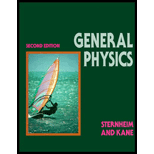
Concept explainers
(a)
The current
(a)
Answer to Problem 89E
The current
Explanation of Solution
The circuit is given in Figure 17.41.
Apply Kirchhoff’s current rule in the junction where the three currents
Solve equation (I) for
Conclusion:
Substitute
Therefore, the current
(b)
The resistance
(b)
Answer to Problem 89E
The resistance
Explanation of Solution
The circuit is given in Figure 17.41. Apply Kirchhoff’s voltage rule in the loop involving the resistors
Solve equation (III) for
Conclusion:
Substitute
Therefore, the resistance
(c)
The EMF
(c)
Answer to Problem 89E
The EMF
Explanation of Solution
The circuit is given in Figure 17.41. Apply Kirchhoff’s voltage rule in the loop involving the resistors
Solve equation (V) for
Conclusion:
Substitute
Therefore, the EMF
Want to see more full solutions like this?
Chapter 17 Solutions
General Physics, 2nd Edition
- With a 1200-W toaster, how much electrical energy is needed to make a slice of toast (cooking time = 1 minute)? At 9.0 cents/kW · h , how much does this cost?arrow_forwardAn 18.0 W device has 9.00 V across it. How much charge goes through the device in 4.00 h?arrow_forwardA cell phone contains a battery rated at 2600 mA # h = 2.60 A # h. How many electrons can this battery supply to thephone?arrow_forward
- An incandescent light bulb is rated at 35.6 W when operated at 93.8 V. How much charge (in C) passes through this bulb in 2.7 minute?arrow_forwardI need help with prt 5, thanksarrow_forwardAn electric device delivers a current of 5 A for 10 seconds. How many electrons (1.6x10-19 C) flow through this device? Select one: a. 3.1x1020 b. 2 c. 20 d. 31x1020 e. 0.2arrow_forward
- List the answers for these: 1. V1 2. I1 3. V2 4. I2 5. V3 6. I3 7. V4 8. I4 9. IT 10. RT 11. Power(w) consumed by the circuit =arrow_forwardWhat happens internally to a battery when it gets old?arrow_forwardThe batteries of a submerged non-nuclear submarine supply 1000 A at full speed ahead. How long does it take to move Avogadro’s number (6.02 1023) of electrons at this rate?arrow_forward
- For the two resistors shown in Figure 17.12, rank the currents at points a through f from largest to smallest. (a) Ia = Ib Ie = If Ic = Id (b) Ia= Ib Ic = Id Ie = If (c) Ie = If Ic = Id Ia = Ib Figure 17.12 (Quick Quiz 17.8)arrow_forwardIf electrical energy costs 0.12 per kilowatt-hour, how much does it cost to (a) burn a 100-W lightbulb for 24 h? (b) Operate an electric oven for 5.0 h if it carries a current of 20.0 A at 220 V?arrow_forwardCheck Your Understanding If you place a wire directly across the two terminal of a battery, effectively shorting out the terminals, the battery will begin to get hot. Wiry do you suppose this happens?arrow_forward
 College PhysicsPhysicsISBN:9781285737027Author:Raymond A. Serway, Chris VuillePublisher:Cengage Learning
College PhysicsPhysicsISBN:9781285737027Author:Raymond A. Serway, Chris VuillePublisher:Cengage Learning College PhysicsPhysicsISBN:9781305952300Author:Raymond A. Serway, Chris VuillePublisher:Cengage Learning
College PhysicsPhysicsISBN:9781305952300Author:Raymond A. Serway, Chris VuillePublisher:Cengage Learning Principles of Physics: A Calculus-Based TextPhysicsISBN:9781133104261Author:Raymond A. Serway, John W. JewettPublisher:Cengage Learning
Principles of Physics: A Calculus-Based TextPhysicsISBN:9781133104261Author:Raymond A. Serway, John W. JewettPublisher:Cengage Learning College PhysicsPhysicsISBN:9781938168000Author:Paul Peter Urone, Roger HinrichsPublisher:OpenStax College
College PhysicsPhysicsISBN:9781938168000Author:Paul Peter Urone, Roger HinrichsPublisher:OpenStax College
 Glencoe Physics: Principles and Problems, Student...PhysicsISBN:9780078807213Author:Paul W. ZitzewitzPublisher:Glencoe/McGraw-Hill
Glencoe Physics: Principles and Problems, Student...PhysicsISBN:9780078807213Author:Paul W. ZitzewitzPublisher:Glencoe/McGraw-Hill





